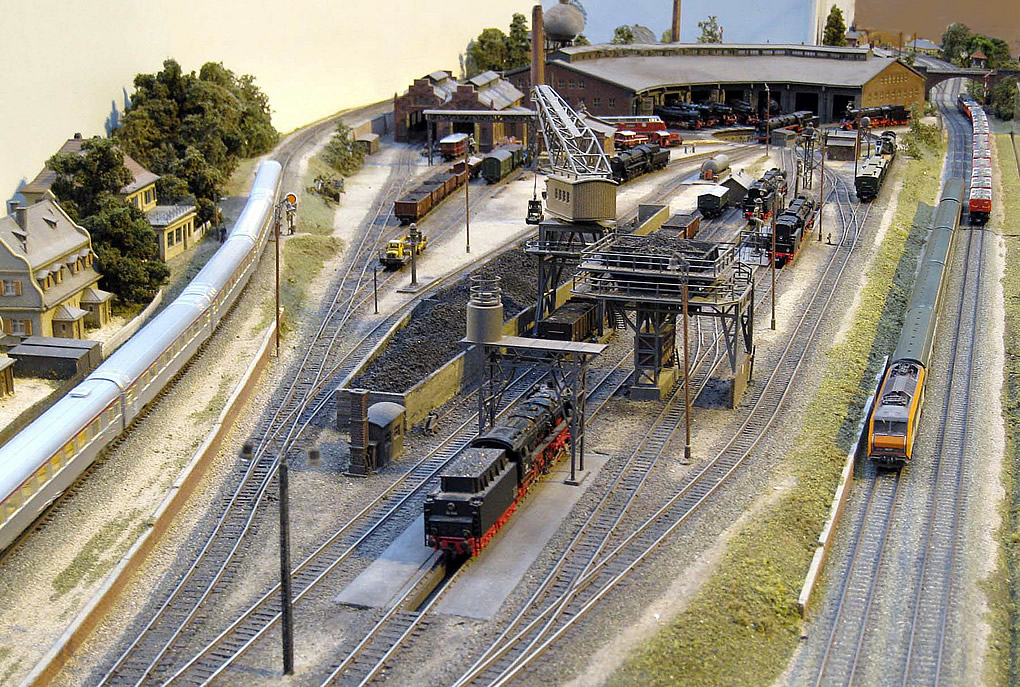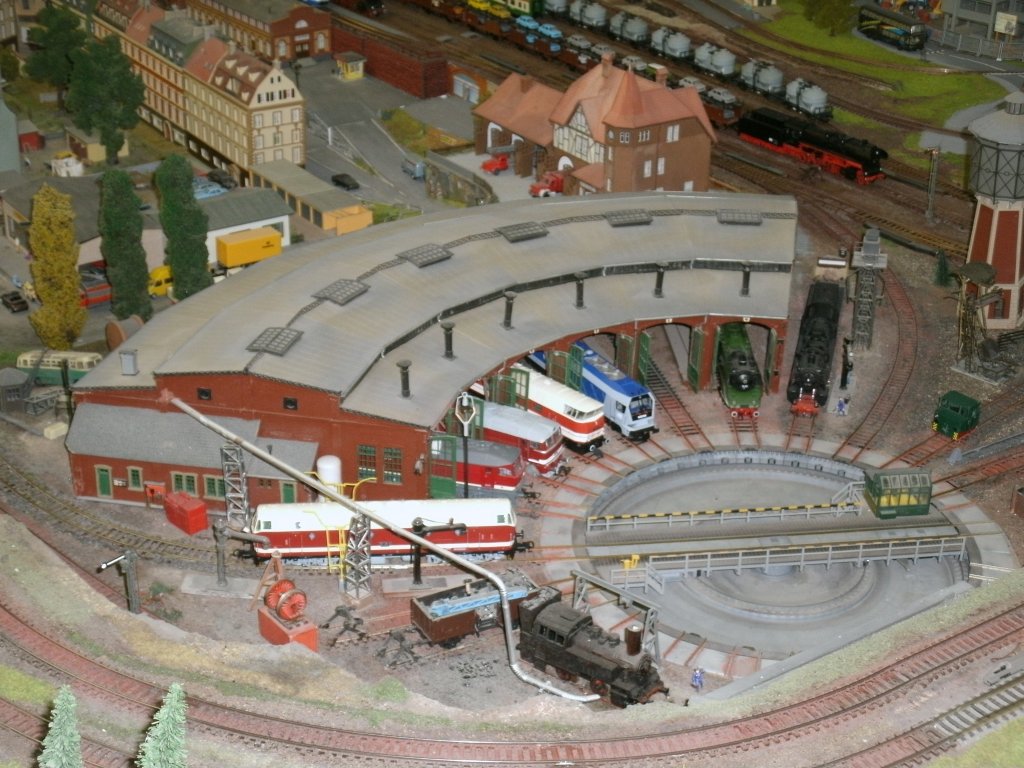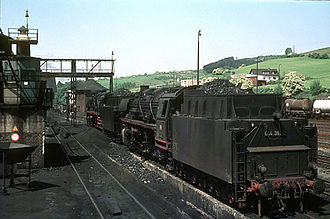Bahnbetriebswerk
As a railway depot, also briefly depot ( Abbr: BW ) is referred to in the German railways, a plant which is used for maintenance, minor repairs, the addition of materials and the cleaning of locomotives and railcars. Moreover, the use of locomotives and locomotive staff is organized. At Deutsche Bahn today Bahnbetriebswerke as depots, at ÖBB but as Zugförderungsstellen ( Zf) are referred to. In many other countries the term custodian is often simply related. The railway depots were annexed (also use points or Lokbahnhöfe ) organizationally and operationally the smaller Lokstationen.
- 2.1 steam era
- 2.2 diesel and electric locomotives
History
Initial operating workshops
The railways of the German-speaking world were the first workshops for maintenance, repair and supply attitude of railway vehicles, but in particular, the following locomotives operating workshops.
In the first facilities of its kind in 1835, though initially delivered in individual parts of England locomotives were assembled, such as the show on January 7, 1835 opened the depot site for the locomotives of the first mechanically operated Ludwigsbahn Nuremberg -Fürth with the first good working locomotive in Germany, the eagle
John Stanley Blenkinsop, son of the locomotive designer John Blenkinsop first recognized that well- equipped workshops and appropriate personnel are needed for a smooth rail operations. The Duchy of Brunswick State Railway gave him the technical management of the company, then in 1838 the first operational workshop was built, in addition to routine tasks, new locomotives were built. In 1845, John Blekinsop became clear that it was much more cost effective, locomotives waiting on a regular basis than to repair something only when a technical malfunction. This laid the foundation for the later standard tasks was laid by railway depots.
Since the radius of the first steam locomotives was only up to 80 kilometers, were at all major railway stations Equipment for servicing of locomotives built, filled in where the coal and water supplies again especially, as well as cleaning and waste disposal of Aschkästen and the smoke chambers could be made. In branch stations were also built such plants.
In the advanced state of development of the railways, there was also partially the conversion of operating workshops in larger and equipped for more demanding tasks main workshops that are now referred to as " repair work". Gradually annexed all other German railway companies their maintenance and repair facilities along the lines of Ludwig Railway and the Brunswick State Railway.
Other operating workshops of this period were
- The depot casting, built in 1850 as an operating workshop,
- The depot Meiningen, built in 1863 by the " Werra Railway Company " as the operating workshop, which was converted into a main workshop on April 1, 1902
- The operation workshop Barmen- Rittershausen, since 1911 replaced by the depot Wuppertal-Langerfeld/Schwelm,
- The depot Remscheid -Lennep, built around 1890 as a depot site Lennep,
- The depot Treuchtlingen built around 1880 as a Royal Bavarian operation workshop Treuchtlingen,
- The depot Stolberg, built as a depot site Stolberg 1898
Provincial railroad period
Since the 1860s all the rail companies separated the areas of operational services ( use of locomotives ) and vehicle entertainment. In addition, with time came the first repair workshops, called at that time the main workshops. With the founding of the German Empire, the above mentioned system has been adopted by all, as well as many private railways were nationalized, making this system prevailed final.
German Reichsbahn 1920-1945
With the acquisition of the German state railways by the State Treaty of 30 April 1920, the organization of the operating engine department in the whole of Germany was unified. The German Reichsbahn (DR ) is also formed various Reichsbahn divisions and offices machine. On August 1, 1935 there were 27 Reichsbahn divisions and 132 offices machine.
The newly introduced in the 1920s organization scheme proved to be true, yet the number of depots varied considerably. The DR transformed into large Lokbahnhöfe own depots. With the founding of the Deutsche Reichsbahn that changed but abruptly. One fifth of the reparations to the victors of the First World War should generate the DRG. In order to do this, had to rationalization measures are taken, especially savings have been carried out in almost all areas. In addition, the administration had to be streamlined, resulting in the subsequent closure of all smaller depots. At the same time we created so-called Great Bahnbetriebswerke. Medium and small departments were often incorporated into these depots. So huge depots, which had a variety of maintenance systems have been installed. Examples are the depot Dresden- Friedrichstadt and works in Hamburg- Altona, Hamm and Osnabrück. These were often responsible for the maintenance of over 150 locomotives.
German Federal Railroad 1949-1993
The German Federal Railroad began in 1950 small depots in remote locations to convert. This development was accelerated by the traction change, that it is sufficient for diesel and electric locomotives significantly less staff. The fall in freight and passenger transport was unnecessary bit of depot capacity. From 1956 to 1969, the German Federal Railroad broke up a total of 77 depots. The end of the steam era in the DB led to further closures.
German Reichsbahn 1949-1993
Opposite route went first the German Reichsbahn in the GDR. Many smaller Lokbahnhöfe were first raised to railway depots, in particular to ensure better maintenance of the locomotives on site. Only with the beginning of the traction change from the mid-1960s began a trend similar to the DB. Smaller depots have now been resolved, but they remained mostly as a locomotive operation sites still in operation. Most existing systems have been adapted for the diesel and Elektrolokwartung, a new modern maintenance hangars was realized only in a few cases.
German Bahn AG from 1994
Railway Reform and the founding of the Deutsche Bahn, the century-old concepts of operation were completely restructured - the unity of operating service and entertainment was abandoned. These two tasks were taken over traction and works of the business units. The operation works were renamed depots, these have always been under a separate head. With this restructuring, the works were only to providers of maintenance tasks that have been issued by the division traction. With this perfect reorganization we also saw a wave of rationalization at Deutsche Bahn, which led to the closure of plants and depots. In the territory of the former Deutsche Reichsbahn even wholesale depots were closed. For the use of new locomotives, such as the ICE, depots must be repeatedly and comprehensively renovated to maintain the new vehicles.
Tasks
Depots are responsible for maintaining and performing minor repairs to the locomotives used in the operation. In addition, the depot of the workforce is planned and scheduled as drivers. In a certain rhythm (usually 1-2 × per week) an inspection and functional testing of all components of the locomotive is performed by the lookup locksmith. Larger Bahnbetriebswerke with the appropriate technical equipment also carry out major repairs such as swapping engines or the reprofiling of the wheel sets by Unterflurradsatzdrehbank itself.
Steam engine time
Most extensive were once the work that was performed on a steam locomotive maintenance. In addition to populating the operating supplies of water, coal and sand brake the slag was to the steam locomotives daily from rust and clean the smoke chamber. Also the oiling all bearings belonged to the daily workload of a steam locomotive. Important was also the turning of a Tender locomotives according to the intended direction of travel. In a certain rhythm and the washing of the boiler was one of the major maintenance work in the Bw
Diesel and electric locomotives
With the change of motive power from steam to diesel and electric locomotives a comprehensive Umprofilierung the Bahnbetriebswerke was necessary. Plants that were only needed for the maintenance of steam locomotives, had no meaning. For the Elektrolokeinsatz to the Bw'en the construction of additional overhead lines and for the sheltering of diesel locomotives of fueling equipment was needed.
The scope of work in the maintenance of electric locomotives mainly comprises the complete brake sand supplies, the oiling of the less lubrication points and axle, swapping the drive motor brushes, cleaning and trading of a variety of electrical circuit elements, the care of the pantographs and some function tests - especially of train protection systems, drive control and power control.
On diesel locomotives also braking sand inventories need to be supplemented, provides lubrication points, function samples are made to train protection and traction control. Additional tasks include maintenance on the engine, transmission and exhaust gas turbocharger, the changing of oil fillings and various filters and injectors perform. Inspection and maintenance are also necessary for the equipment of the electric power supply of locomotive and train.
Presence
Modern diesel and electric locomotives require the use of many low-maintenance and wear- free components are now only very little maintenance. For this reason, there are now as opposed to the steam era only a few train depots, where some of the servicing and maintenance is concentrated a whole series.
At Deutsche Bahn today depots mentioned Bahnbetriebswerke are increasingly independent and split into several business units of DB AG. With the ÖBB, the division "Technical Services" is responsible. In most operations centers also provide services for other businesses are carried out, such as the maintenance of the vehicles of private railways. This is due to the fact that the construction of a separate depot for private railway companies is often not affordable - that's why the maintenance tasks are often delivered to depots of State Railways.
The depots are demarcated areas that are not usually open to the public. The work is done not only during the day but mostly at night, when many locomotives are not required for traction. ICEs or other railcars are also parked in the depot, this area is not accessible, so there is no graffiti problem in the locomotives, as in unprotected parked freight cars is often the case.
With depots that still have buildings from the steam era, there are extension problems more often. Buildings that are under the industrial monument protection, may not be demolished. Otherwise depots are basically designed so that an expansion in all directions is possible. At the planning stage must be kept in mind that enough additional reason is available, which can be bought easily in the case of expansion plans.
Former depots are often used never again run wild and completely. Often the tracks are completely dismantled, only the listed buildings remain available. However, there is in Germany a project to convert a former railway depot in the largest railway adventure world of the country. Here, the already dilapidated buildings will be again restored to the original.
Special Forces trains
In addition to the maintenance of all locomotives some depots are also responsible for the maintenance of special use features, it also the traction change nothing has changed. The most important units are auxiliary features ( for re- tracks of entgleistem rolling stock) and snow removal. Until the 1980s there were also fire-fighting trains, whose duties were, however, now taken over by train fire departments. For the smooth running of a depot towing or shunting vehicles are required to move the cars and do not drive capable locomotives. Until 20 years ago there were other special-purpose vehicles, such as waste oil trains but now all were retired.










